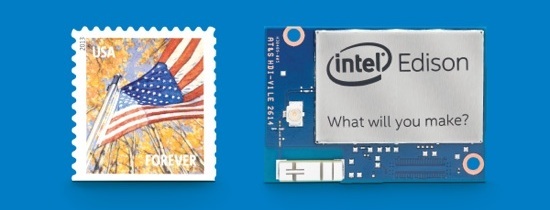
The smartwatch market is hardly a surefire bet, despite hopes that the Apple Watch will spur the market. However, the larger market for wearables, which includes smartwatches, eyewear, and smart clothing and accessories seem destined for greatness.
Linux-based platforms for wearables include Android Wear, Samsung’s Tizen SDK for Wearables, and now Intel’s Edison computing module, built on Yocto-based Linux and the Intel Atom processor. The Edison was released last week in conjunction with the Intel Developer Forum. Prior to the formal launch, some 70 Intel Edison beta units have been seeded, forming the basis for about 40 Edison-based projects, says Intel.
In the Intel view, the smartwatch is only the highest profile member of a booming ecosystem of wearables and other Internet of Things devices that can run on the common, Arduino-compatible Edison platform. Intel is definitely interested in watches, however. Earlier this year, the chipmaker acquired a watch company called Basic, and at IDF, former Apple exec Mike Bell, now VP of Intel’s New Devices Group, teased a new Basic Peak model due to ship by year’s end that appears to run on the Edison. Intel is also collaborating with watchmaker Fossil on another project, and with Barney’s and Opening Ceremony on a luxury Mica fitness watch.
At IDF, many more Edison-based projects were demonstrated. Chris Anderson, CEO of 3D Robotics, showed an Edison-based quad-copter drone, and Meridian Audio announced wireless speaker endpoints. There was also a Trossen Robotics robot, a Braille printer, and a fitness shirt. Intel even showed a Connected Wheelchair Project announced with physicist Stephen Hawking.
Atom and Quark share space on Tangiers SoC
The $50 Edison module has changed from the original plan. Back in April, Intel announced that instead of using a new dual-core version of its Pentium-compatible, low-power Quark, it would first ship a dual-core Atom version, and would follow up later with a Quark model. As it turns out, both the Atom and Quark are integrated on the same Atom Z34xx (“Merrifield”) based system-on-chip called the Tangiers.
The Tangiers SoC clocks down its Atom cores to a 500MHz, and strips out the some advanced smartphone focused features. In the first generation, the Quark will be inactive, but when it is eventually switched on, it will be clocked down to 100MHz and act primarily like a microcontroller companion chip. The Quark will not run Linux, as it does on Intel’s Galileo hacker boards, but rather a new “ViperOS” real-time operating system derived from the VxWorks RTOS platform provided by Intel subsidiary Wind River.
Like Wind River Linux, the stack running on the Atom part of the Tangiers is based on Yocto-based Linux 1.6. Among other development tools, Intel is launching an Analytics for Wearables (A-Wear) developer program with Cloudera to offer Hadoop-based cloud services to Edison projects.
Two maker-focused development boards are provided for the board: a simple Edison Breakout Board and a more extensive Arduino-enabled version. SparkFun, which resells the boards along with Mouser and Maker Shed, offers over a dozen of its own SparkFun Blocks add-ons, which can stack on the module to add displays, batteries, industrial interfaces, and motor control.
It remains to be seen whether the Edison is picked up by big-name consumer electronics companies, which have largely adopted Android Wear or are selling “dumber” smartwatches without formal OSes. Yet, with the open source Yocto Project community behind it, we should see plenty of innovation in wearables and other IoT devices from smaller companies.


